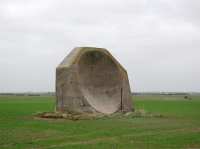
Early Warning
by Richard Monks
Richard Monks introduces his play about a deaf teenager who believes she's witness to a murder ...(R3, 23 Feb 2013, 55m)
Some ideas begin with a character; some with a story or a theme. Early Warning began with a photograph: a black and white image of a concrete dish; a massive monolith from fifteen to twenty feet in diameter. It was like a giant satellite dish, stood isolated on a shingle beach, beneath and enormous sky, and I remember wondering what on earth this thing was. I was intrigued; this strange, brutalist piece of architecture.
Sometime later, talking to a friend who lived on the coast, I discovered that it was an acoustic mirror, built before the First World War as part of an early warning system in order to detect incoming enemy aircraft. They were known locally as 'listening ears'.
Even though I was convinced that these sound sculptures offered potential for a radio play, it took me a while to work out exactly how to oncorporate them into some kind of narrative. I needed a way in; a human story. As tends to happen, if you think long and hard enough, characters do begin to emerge, and as they are brought into focus you begin to hear their voices; once indistinct, they become real.
By the time I started to write the script I found I had discovered my protaganist; a profoundly deaf girl called Ella; an outsider, recently moved the the coast; someone for whom the listening ear plays a critical role.
During my research to discover what it's like to inhabit Ella's world I met with an audiologist and a group of deaf teenagers who gave me an invaluable insight into their lives. From the time spent talking to them, certain themes began to emerge: isolation, frustration, alienation; things which sparked new thoughts, new characters and storylines, all of which felt as if they were bouncing around in the centre of this huge concrete dish, ricocheting off each other like particles of sound; colliding, creating conflict. My job then was to listen, to try and make sense of it all, just as Ella must do in this play ...
RT details - Taking refuge in a bunker under a 'sound mirror', Ella hears a noise and believes she has witnessed a murder. However her evidence is dismissed as unreliable; she is young, and she is deaf.
Ella ... Rose Ayling-Ellis, Birdman .... Robert Pickavance, Leanne .... Rachel Austin, Clare / PC .... Ruth Alexander-Rubin, Alastair ..... Jason Done, Audiologist / Craig ..... Matthew McNulty. Producer .... Nadia Molinari.
Acoustic aircraft detection
Prior to World War II and the invention of radar, acoustic mirrors were built as early warning devices around the coasts of Great Britain, with the aim of detecting incoming enemy aircraft by the sound of their engines. There are some at Denge on the Dungeness peninsula, at Hythe in Kent and in other parts of Britain.
Microphones placed at the focus of the reflector enabled a listener to detect the sound of aircraft far out over the English Channel. The reflectors are not parabolic, but are spherical mirrors; these may be used for direction finding by moving the sensor rather than the mirror. The acoustic mirror programme was led by Dr William Sansome Tucker, developing the methodology of using interconnected stations to pinpoint the position of an enemy in the sky. These ideas were incorporated into the development of radar during WW2.

WW1 Acoustic Mirror, Kilnsea, East Riding of Yorkshire, Great Britain Rare 4.5 metre high concrete structure near Kilnsea Grange, northwest of Godwin Battery, a relic of the First World War. On the pipe in front of the acoustic mirror was a detector or microphone which relayed the sound to a lower chamber. Photograph by Paul Glazzard, and copied by permission from 'Wikipedia'.
Sitemap